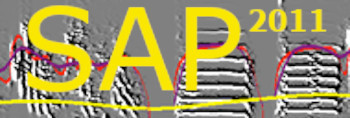Syntax DVD maps
| < PREVIOUS: Cumulative DVD maps_________________________________________________ | > NEXT: 3D DVD maps |
|
|
|
|
|
|
The syntax mode
Click on the 'Syllable movies in 2D' tab and select the syntax mode. Note that the interval and slide positions have changed, and that 'Draw lines' is now checked. Open syll_R109 and move the time control slider to the middle of the range. Set color scheme to color by cluster and the Y axis feature (right of the chart) to mean p-goodness. Click start:
Move the time control to the later stages of song development, select duration for X and pitch for Y axis. Set the color scheme to user defined and select red. Then click 'DVD Play/Stop'. Instead of looking at the syllables as dots, we now look at the trajectories that connect them in time. That is, the order of singing the song syllables is now represented by lines that connect those syllables. When a short duration syllable is followed by a longer duration syllable, SAP2011 will paint the line red, and when a long syllable is followed by a shorter one, the line is blue. It is immediately apparent by the movie, that the song is stereotyped; however, it is also easy to see drifts in the pattern. As shown, the shape equivalent of this song is a triangle. Each projection (using different features) will give a different view of this syntax patters, obviously, some projections are nicer then others. We can now explore the syntax development of this song. Moving the slider back to the original setting, duration versus FM, shows nice transitions of syntax structure during development as exemplified in the figure to your right. Note how the blue and red 'streams' get separated during development as the third song syllable appears, turning the shape into triangle.
Now say that you want to observe the possible effect of circadian time on song syntax: selecting 'color by time of day' will present the trajectories with circadian color, indicating that for some features (e.g., pitch) evening (blue) and morning (red) trajectories differ during early development.
Note that although we call this 'syntax mode' what you actually see is not really syntax, but some combo display capturing both syntax and feature (sort of phonetic) changes. We find this representation particularly useful because there are reasons to believe that the changes of feature structure (within a syllable) and changes of syntax might be linked. For example, a prototype sound can give rise to two different types of sounds (see details in Tchernichovski et al 2001, sound differentiation in situ).
This is a good time to elaborate about the relations between the observed clusters and the actual syllables produced by the bird. The clusters are at best as robust as the segmentation method is, and unfortunately, our current methods of segmentation, based on amplitude and Wiener entropy thresholds are not always robust. The most common type of measurement noise is inconsistency in the segmentation of short attenuations. For example, if the 'real' pattern of syllable is ABC,ABC,ABC… and the pause between B and C is very short, SAP2011 might sometimes join B and C, to give an additional 'combination cluster' that we shall call D. hence, what we observed as ABC,AD,AD,ABC should actually be ABC,ABC,ABC… This problem, once detected, is not too difficult to solve. For example we can re-segment the data (using the binary files rather than the raw sound files) using a more aggressive criteria for partitioning sounds.
It is often useful to change the bout ending dur parameter -- it determine when to cut the lines the connect the syllables. Setting a conservative threshold of, say, 40ms, looks like this:
indicating that short latency transitions are restricted to blue-green syllable types. And setting it high will show this view:
indicating that the transition to call elements usually occurs between the green and red clusters.
